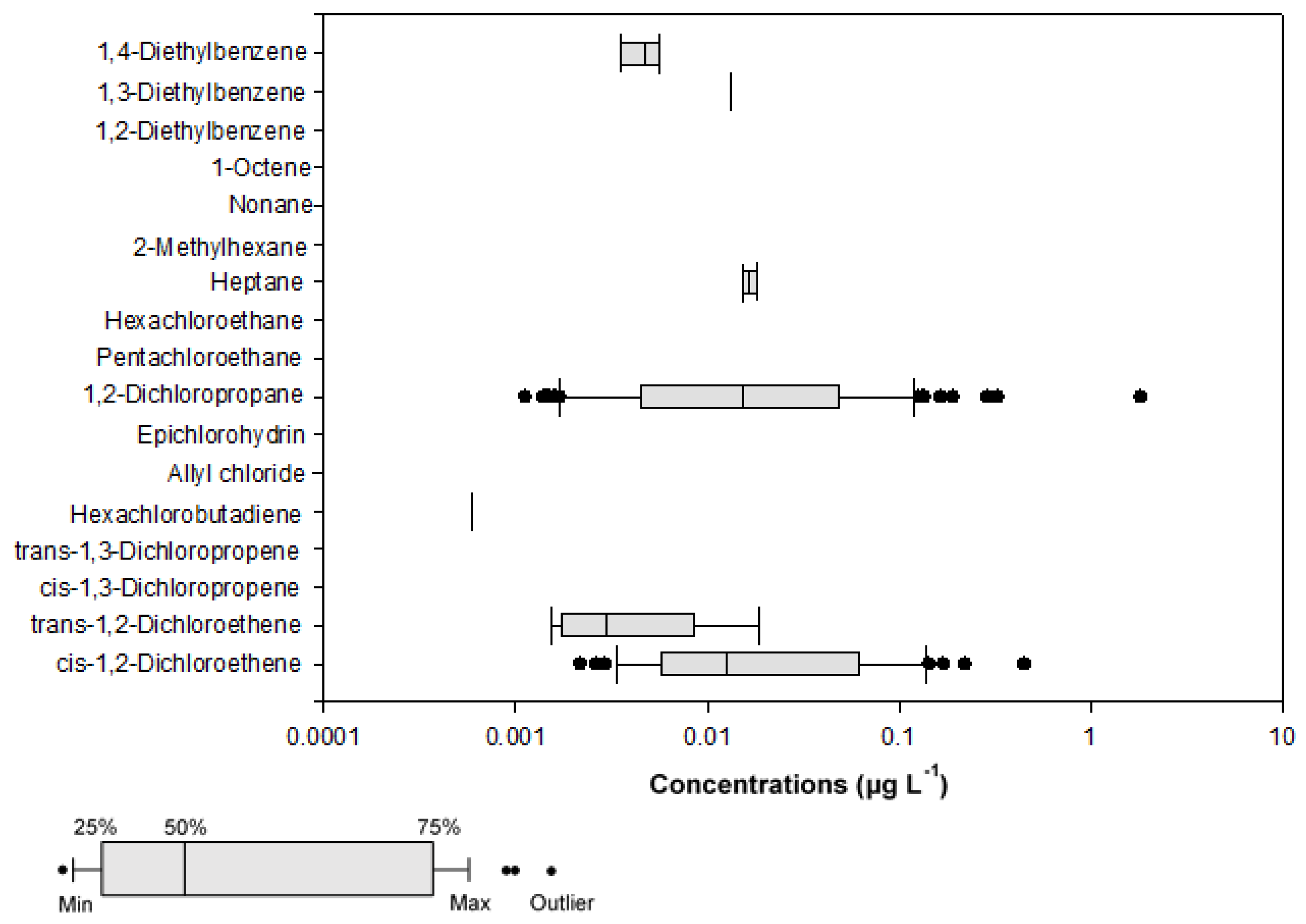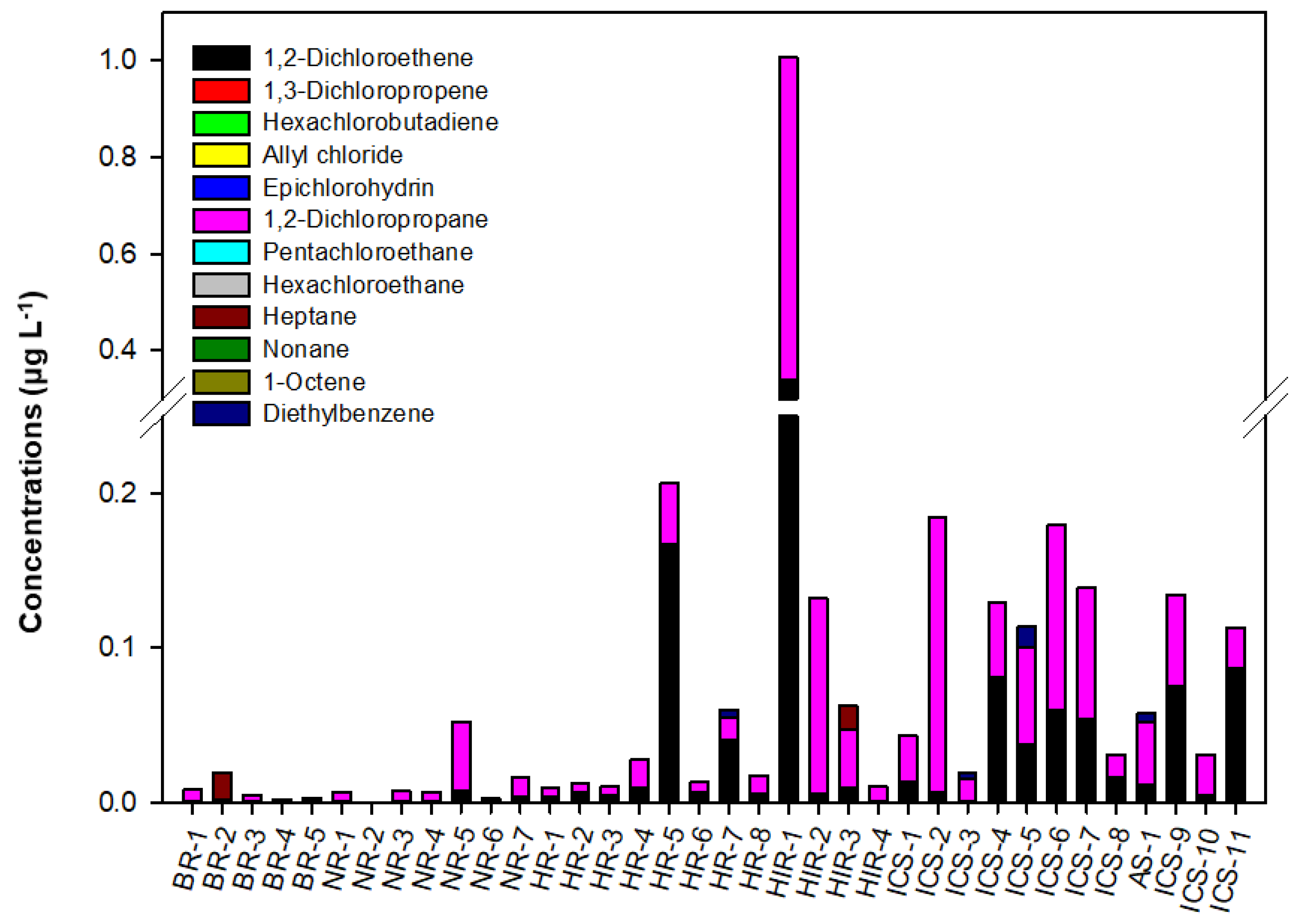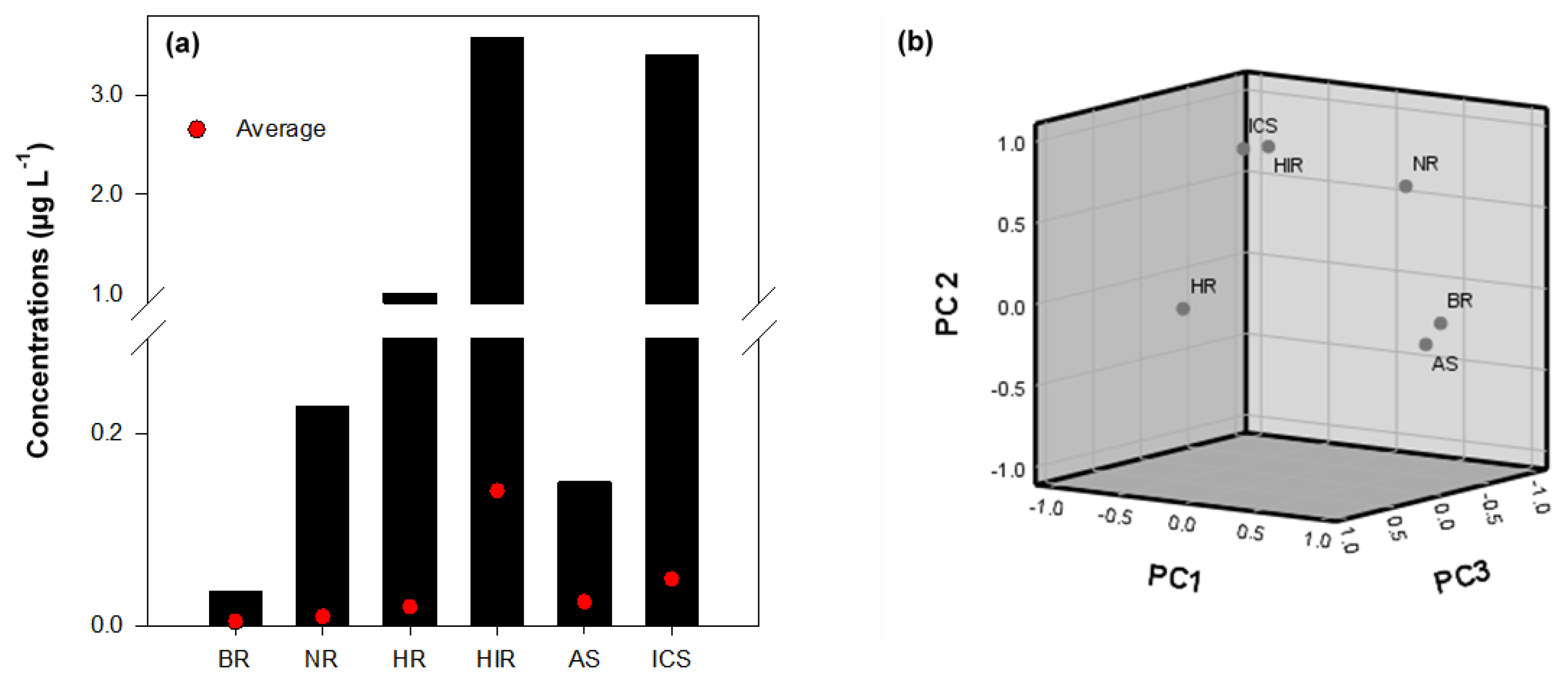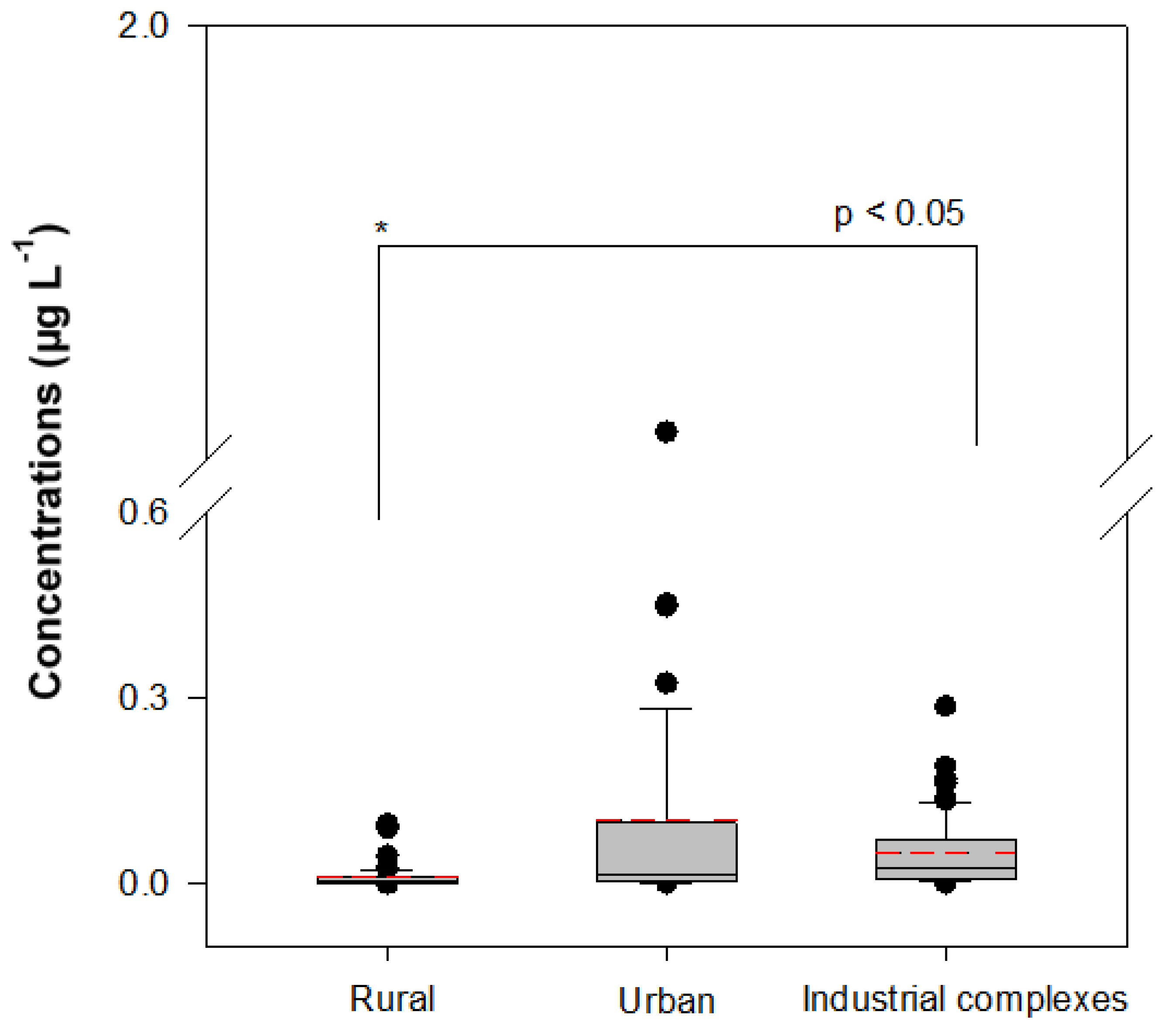Occurrence, Potential Sources, and Risk Assessment of Volatile Organic Compounds in the Han River Basin, South Korea
Abstract
1. Introduction
2. Materials and Methods
2.1. Chemicals and Reagents
2.2. Sampling Sites
2.3. Water Sampling and Analytical Procedures
2.4. Risk Assessment
2.5. Statistical Analysis
3. Results and Discussion
3.1. Occurrence of VOCs
3.2. Geographic Trends
3.3. Potential Sources
3.4. Risk Assessment of VOCs
4. Conclusions
Supplementary Materials
Author Contributions
Funding
Institutional Review Board Statement
Informed Consent Statement
Data Availability Statement
Conflicts of Interest
References
- Cho, E.; Khim, J.; Chung, S.; Seo, D.; Son, Y. Occurrence of micropollutants in four major rivers in Korea. Sci. Total Environ. 2014, 491–492, 138–147. [Google Scholar] [CrossRef] [PubMed]
- Chen, X.; Luo, Q.; Wang, D.; Gao, J.; Wei, Z.; Wang, Z.; Zhou, H.; Mazumder, A. Simultaneous assessments of occurrence, ecological, human health, and organoleptic hazards for 77 VOCs in typical drinking water sources from 5 major river basins, China. Environ. Pollut. 2015, 206, 64–72. [Google Scholar] [CrossRef] [PubMed]
- OECD. Environmental Data, Inland Waters; OECD: Paris, France, 2006. [Google Scholar]
- Wu, B.Z.; Feng, T.Z.; Sree, U.; Chiu, K.H.; Lo, J.G. Sampling and analysis of volatile organics emitted from wastewater treatment plant and drain system of an industrial science park. Anal. Chim. Acta 2006, 576, 100–111. [Google Scholar] [CrossRef] [PubMed]
- Cheng, W.H.; Hsu, S.K.; Chou, M.S. Volatile organic compound emissions from wastewater treatment plants in Taiwan: Legal regulations and costs of control. J. Environ. Manag. 2008, 88, 1485–1494. [Google Scholar] [CrossRef] [PubMed]
- Marti, N.; Aguado, D.; Segovia-Martinez, L.; Bouzas, A.; Seco, A. Occurrence of priority pollutants in WWTP effluents and Mediterranean coastal waters of Spain. Mar. Pollut. Bull 2011, 62, 615–625. [Google Scholar] [CrossRef]
- Kargar, M.; Nadafi, K.; Nabizadeh, R.; Nasseri, S.; Mesdaghinia, A.; Mahvi, A.H.; Alimohammadi, M.; Nazmara, S.; Rastkari, N. Survey of hazardous organic compounds in the groundwater, air and wastewater effluents near the Tehran automobile industry. Bull Environ. Contam Toxicol. 2013, 90, 155–159. [Google Scholar] [CrossRef]
- Padalkar, A.V.; Kumar, R. Removal mechanisms of volatile organic compounds (VOCs) from effluent of common effluent treatment plant (CETP). Chemosphere 2018, 199, 569–584. [Google Scholar] [CrossRef]
- Im, J.K.; Hwang, M.Y.; Lee, E.H.; Noh, H.R.; Yu, S.J. Pharmaceutical compounds in tributaries of the Han River watershed, South Korea. Environ. Res. 2020, 188, 109758. [Google Scholar] [CrossRef]
- Korea Environmental Corporation (KECO). Available online: https://www.keco.or.kr/kr/main/index.do (accessed on 26 November 2020).
- Sivret, E.C.; Wang, B.; Parcsi, G.; Stuetz, R.M. Prioritisation of odorants emitted from sewers using odour activity values. Water Res. 2016, 88, 308–321. [Google Scholar] [CrossRef]
- Kim, S.J.; Kwon, H.O.; Lee, M.I.; Seo, Y.; Choi, S.D. Spatial and temporal variations of volatile organic compounds using passive air samplers in the multi-industrial city of Ulsan, Korea. Environ. Sci. Pollut. Res. Int. 2019, 26, 5831–5841. [Google Scholar] [CrossRef]
- Pavlíková, I.; Hladký, D.; Motyka, O.; Vergel, K.N.; Strelkova, L.P.; Shvetsova, M.S. Characterization of PM10 Sampled on the Top of a Former Mining Tower by the High-Volume Wind Direction-Dependent Sampler Using INNA. Atmosphere 2021, 12, 29. [Google Scholar]
- Lee, S.S.; Kaown, D.; Lee, K.K. Evaluation of the fate and transport of chlorinated ethenes in a complex groundwater system discharging to a stream in Wonju, Korea. J. Contam Hydrol. 2015, 182, 231–243. [Google Scholar] [CrossRef] [PubMed]
- Yu, S.; Lee, P.-K.; Hwang, S.-I. Groundwater contamination with volatile organic compounds in urban and industrial areas: Analysis of co-occurrence and land use effects. Environ. Earth Sci. 2015, 74, 3661–3677. [Google Scholar] [CrossRef]
- Yu, S.; Lee, P.-K.; Yun, S.-T.; Hwang, S.-I.; Chae, G. Comparison of volatile organic compounds in stormwater and groundwater in Seoul metropolitan city, South Korea. Environ. Earth Sci. 2017, 76, 1–17. [Google Scholar] [CrossRef]
- Li, H.; Wang, Y.; Liu, F.; Tong, L.; Li, K.; Yang, H.; Zhang, L. Volatile organic compounds in stormwater from a community of Beijing, China. Environ. Pollut 2018, 239, 554–561. [Google Scholar] [CrossRef] [PubMed]
- Roy, J.W.; Grapentine, L.; Bickerton, G. Ecological effects from groundwater contaminated by volatile organic compounds on an urban stream’s benthic ecosystem. Limnologica 2018, 68, 115–129. [Google Scholar] [CrossRef]
- Orchard, B.; Doucette, W.; Chard, J.; Bugbee, B. A novel laboratory systmen for determining fate of volatile organic compounds in planted systems. Envrion. Toxico Chem. 2000, 19, 888–894. [Google Scholar] [CrossRef]
- Kavcar, P.; Odabasi, M.; Kitis, M.; Inal, F.; Sofuoglu, S.C. Occurrence, oral exposure and risk assessment of volatile organic compounds in drinking water for Izmir. Water Res. 2006, 40, 3219–3230. [Google Scholar] [CrossRef] [PubMed]
- Liu, L.; Zhou, H. Investigation and assessment of volatile organic compounds in water sources in China. Environ. Monit Assess. 2011, 173, 825–836. [Google Scholar] [CrossRef] [PubMed]
- Yuan, B.; Shao, M.; Lu, S.; Wang, B. Source profiles of volatile organic compounds associated with solvent use in Beijing, China. Atmos. Environ. 2010, 44, 1919–1926. [Google Scholar] [CrossRef]
- Shaikh, M.M.; Hanafiah, M.M.; Basheer, A.O. Leaching of Organic Toxic Compounds from PVC Water Pipes in Medina Al-Munawarah, Kingdom of Saudi Arabia. Processes 2019, 7, 641. [Google Scholar] [CrossRef]
- Niri, V.H.; Bragg, L.; Pawliszyn, J. Fast analysis of volatile organic compounds and disinfection by-products in drinking water using solid-phase microextraction-gas chromatography/time-of-flight mass spectrometry. J. Chromatogr. A 2008, 1201, 222–227. [Google Scholar] [CrossRef] [PubMed]
- Ma, H.; Zhang, H.; Wang, L.; Wang, J.; Chen, J. Comprehensive screening and priority ranking of volatile organic compounds in Daliao River, China. Environ. Monit. Assess. 2014, 186, 2813–2821. [Google Scholar] [CrossRef] [PubMed]
- Chary, N.S.; Fernandez-Alba, A.R. Determination of volatile organic compounds in drinking and environmental waters. Trends Analyt Chem. 2012, 32, 60–75. [Google Scholar] [CrossRef]
- Cao, F.; Qin, P.; Lu, S.; He, Q.; Wu, F.; Sun, H.; Wang, L.; Li, L. Measurement of volatile organic compounds and associated risk assessments through ingestion and dermal routes in Dongjiang Lake, China. Ecotoxicol. Environ. Saf. 2018, 165, 645–653. [Google Scholar] [CrossRef] [PubMed]
- Wang, J.; Sui, Q.; Lyu, S.; Huang, Y.; Huang, S.; Wang, B.; Xu, D.; Zhao, W.; Kong, M.; Zhang, Y.; et al. Source apportionment of phenolic compounds based on a simultaneous monitoring of surface water and emission sources: A case study in a typical region adjacent to Taihu Lake watershed. Sci. Total Environ. 2020, 722, 137946. [Google Scholar] [CrossRef]
- Kuster, M.; Diaz-Cruz, S.; Rosell, M.; Lopez de Alda, M.; Barcelo, D. Fate of selected pesticides, estrogens, progestogens and volatile organic compounds during artificial aquifer recharge using surface waters. Chemosphere 2010, 79, 880–886. [Google Scholar] [CrossRef]
- Kong, L.; Kadokami, K.; Wang, S.; Duong, H.T.; Chau, H.T.C. Monitoring of 1300 organic micro-pollutants in surface waters from Tianjin, North China. Chemosphere 2015, 122, 125–130. [Google Scholar] [CrossRef]
- Nikolaou, A.D. Determination of volatile organic compounds in surface waters and treated wastewater in Greece. Water Res. 2002, 36, 2883–2890. [Google Scholar] [CrossRef]
- Juang, D.; Lee, C.; Hsueh, S. Chlorinated volatile organic compounds found near the water surface of heavily polluted rivers. Int. J. Environ. Sci. Technol. 2009, 6, 545–556. [Google Scholar] [CrossRef][Green Version]
- WHO. Guildelines for Drinking Water Quality; WHO: Geneva, Switzerland, 2017. [Google Scholar]
- US EPA. Drinking Water Standards and Health Advisories; US EPA: Washington, DC, USA, 2018.
- Korean Ministry of Environment. Statistics of Waterworks; Korean Ministry of Environment: Sejong, Korea, 2017.
- Im, J.K.; Kim, S.H.; Noh, H.R.; Yu, S.J. Temporal-spatial variation and environmental risk assessment of pharmaceuticals in tributaries of the Han River watershed, South Korea. Sci. Total Environ. 2020, 741, 140486. [Google Scholar] [CrossRef] [PubMed]
- Korean Water Resources Management Information System (WAMIS). Available online: http://www.wamis.go.kr (accessed on 26 November 2020).
- European Commission (EC). Technical Guidance Documnet for Deriving Environmental Quality Standards; European Commission (EC): Brussels, Belgium, 2018; p. 31. [Google Scholar]
- ECOTOX. Available online: https://cfpub.epa.gov/ecotox/ (accessed on 26 November 2020).
- Pecoraino, G.; Scalici, L.; Avellone, G.; Ceraulo, L.; Favara, R.; Candela, E.G.; Provenzano, M.C.; Scaletta, C. Distribution of volatile organic compounds in Sicilian groundwaters analysed by head space-solid phase micro extraction coupled with gas chromatography mass spectrometry (SPME/GC/MS). Water Res. 2008, 42, 3563–3577. [Google Scholar] [CrossRef] [PubMed]
- Safarova, V.I.; Sapelnikova, S.V.; Djazhenko, E.V.; Teplova, G.I.; Shajdulina, G.F.; Kudasheva, F. Gas chromatography-mass spectrometry with headspace for the analysis of volatile organic compounds in waste water. J. Chromatogr. B Analyt Technol. Biomed. Life Sci. 2004, 800, 325–330. [Google Scholar] [CrossRef]
- Al-Mudhaf, H.F.; Alsharifi, F.A.; Abu-Shady, A.S. A survey of organic contaminants in household and bottled drinking waters in Kuwait. Sci. Total Environ. 2009, 407, 1658–1668. [Google Scholar] [CrossRef]
- Huybrechts, T.; Dewulf, J.; Van Langenhove, H. Priority volatile organic compounds in surface waters of the southern North Sea. Environ. Pollut 2005, 133, 255–264. [Google Scholar] [CrossRef]
- Japan Water Works Association (JWWA). Water Supply in Japan; Japan Water Works Association (JWWA): Tokyo, Japan, 2017. [Google Scholar]
- Moran, M.; Grady, S.; Zpgorski, J. Occurrence and distribution of volatile organic compounds in driking water supplied by community water systems in the Northeast and Mid-Atlantic Regions of the United States, 1993–1998. USGS Rep. 2001. [Google Scholar] [CrossRef][Green Version]
- Squillace, P.J.; Scott, J.C.; Moran, M.J.; Nolan, B.T.; Kolpin, D.W. VOCs, Pesticides, Nitrate, and Tehir Mictures in Groundwater Used for Drinking Water in the United States. Environ. Sci. Technol. 2002, 36, 1923–1930. [Google Scholar] [CrossRef]
- Squillace, P.J.; Moran, M.J.; Price, C.V. VOCs in Shallow Groundwater in New residential/Commercial Areas of the United States. Environ. Sci. Technol. 2004, 38, 5327–5338. [Google Scholar] [CrossRef]
- Korean Pollutant Release and Transfer Register (PRTR). Available online: https://icis.me.go.kr/prtr/main.do (accessed on 26 November 2020).
- Risk Evaluation for 1,2-Dichlropropane. Available online: https://www.epa.gov/assessing-and-managing-chemicals-under-tsca/risk-evaluation-12-dichloropropane (accessed on 26 November 2020).
- Lee, H.J.; Kong, D.S.; Kim, S.H.; Shin, K.S.; Park, J.H.; Kim, B.I.; Kim, S.M.; Jang, S.H.; Cheon, S.U. Investigation on water quality variation characteristics during dry season in Namhan River drainage basin. J. Korean Soc. Water Qual. 2007, 23, 889–896. [Google Scholar]
- Huang, Y.; Sui, Q.; Lyu, S.; Wang, J.; Huang, S.; Zhao, W.; Wang, B.; Xu, D.; Kong, M.; Zhang, Y.; et al. Tracking emission sources of PAHs in a region with pollution-intensive industries, Taihu Basin: From potential pollution sources to surface water. Environ. Pollut. 2020, 264, 114674. [Google Scholar] [CrossRef] [PubMed]
- Shabanpour, M.; Daneshyar, M.; Parhizkar, M.; Lucas-Borja, M.E.; Antonio Zema, D. Influence of crops on soil properties in agricultural lands of northern Iran. Sci. Total Environ. 2020, 711, 134694. [Google Scholar] [CrossRef]
- El-Metwally, M.E.A.; Darwish, D.H.; Dar, M.A. Spatial distribution and contamination assessment of heavy metals in surface sediments of Lake Burullus, Egypt. Arab J. Geosci. 2021, 14. [Google Scholar]
- Mullaugh, K.M.; Hamilton, J.M.; Avery, G.B.; Felix, J.D.; Mead, R.N.; Willey, J.D.; Kieber, R.J. Temporal and spatial variability of trace volatile organic compounds in rainwater. Chemosphere 2015, 134, 203–209. [Google Scholar] [CrossRef] [PubMed]
- Ellis, P.A.; Rivett, M.O. Assessing the impact of VOC-contaminated groundwater on surface water at the city scale. J. Contam Hydrol. 2007, 91, 107–127. [Google Scholar] [CrossRef]
- Tsai, K.-P.; Chen, C.-Y. An algal toxicity database of organic toxicants derived by a closed-system technique. Environ. Toxicol. Chem. 2007, 26, 1931–1939. [Google Scholar] [CrossRef] [PubMed]
- Geiger, D.L.; Northcott, C.E.; Call, D.J.; Brooke, L.T. Acute Toxicities of Organic Chemicals to Fathead Minnows (Pimephales promelas): Volume II; Center for Lake Superior Environmental Studies, University of Wisconsin-Superior: Superior, WI, USA, 1985. [Google Scholar]
- Benoit, D.A.; Puglisi, F.A.; Olson, D.L.A. Fathead Minnow Pimephales Promelas Early Life Stage Toxicity Test Method Evaluation and Exposure to Four Organic Chemicals. Environ. Pollut 1982, 28, 189–197. [Google Scholar] [CrossRef]





| Compound | Min (µg L−1) | Max (µg L−1) | Average ± SD (µg L−1) | DF (%) |
|---|---|---|---|---|
| cis-1,2-Dichloroethene | 0.0022 | 0.4528 | 0.0523 ± 0.0909 | 52.78 |
| trans-1,2-Dichloroethene | 0.0016 | 0.0187 | 0.0055 ± 0.0066 | 5.56 |
| cis-1,3-Dichloropropene | ND | ND | ND | ND |
| trans-1,3-Dichloropropene | ND | ND | ND | ND |
| Hexachlorobutadiene | 0.0006 | 0.0006 | 0.0006 | 0.93 |
| Allyl chloride | ND | ND | ND | ND |
| Epichlorohydrin | ND | ND | ND | ND |
| 1,2-Dichloropropane | 0.0011 | 1.8131 | 0.0595 ± 0.1989 | 80.56 |
| Pentachloroethane | ND | ND | ND | ND |
| Hexachloroethane | ND | ND | ND | ND |
| Heptane | 0.0153 | 0.0180 | 0.0167 ± 0.0019 | 1.85 |
| 2-Methylhexane | ND | ND | ND | ND |
| 1-Octene | ND | ND | ND | ND |
| Nonane | ND | ND | ND | ND |
| 1,2-Diethylbenzene | ND | ND | ND | ND |
| 1,3-Diethylbenzene | 0.0133 | 0.0133 | 0.0133 | 0.93 |
| 1,4-Diethylbenzene | 0.0036 | 0.0056 | 0.0046 ± 0.0010 | 2.78 |
| Total VOCs | 0.0525 ± 0.1581 |
| Compound | Lowest PNEC (μg L−1) | Toxicity Endpoint | Max. MEC (μg L−1) | RQs | References |
|---|---|---|---|---|---|
| cis-1,2-Dichloroethene | 59.7 | Pseudokirchneriella subcapitata Population, EC50 | 0.4528 | 0.0076 | [56] |
| trans-1,2-Dichloroethene | 36.4 | Pseudokirchneriella subcapitata Population, EC50 | 0.0187 | 0.0005 | [56] |
| Hexachlorobutadiene | 0.130 | Pimephales promelas Mortality, NOEC | 0.0006 | 0.0046 | [57] |
| 1,2-Dichloropropane | 120 | Pimephales promelas Growth, NOEC | 1.8131 | 0.0151 | [58] |
Publisher’s Note: MDPI stays neutral with regard to jurisdictional claims in published maps and institutional affiliations. |
© 2021 by the authors. Licensee MDPI, Basel, Switzerland. This article is an open access article distributed under the terms and conditions of the Creative Commons Attribution (CC BY) license (https://creativecommons.org/licenses/by/4.0/).
Share and Cite
Im, J.K.; Yu, S.J.; Kim, S.; Kim, S.H.; Noh, H.R.; Kim, M.K. Occurrence, Potential Sources, and Risk Assessment of Volatile Organic Compounds in the Han River Basin, South Korea. Int. J. Environ. Res. Public Health 2021, 18, 3727. https://doi.org/10.3390/ijerph18073727
Im JK, Yu SJ, Kim S, Kim SH, Noh HR, Kim MK. Occurrence, Potential Sources, and Risk Assessment of Volatile Organic Compounds in the Han River Basin, South Korea. International Journal of Environmental Research and Public Health. 2021; 18(7):3727. https://doi.org/10.3390/ijerph18073727
Chicago/Turabian StyleIm, Jong Kwon, Soon Ju Yu, Sujin Kim, Sang Hun Kim, Hye Ran Noh, and Moon Kyung Kim. 2021. "Occurrence, Potential Sources, and Risk Assessment of Volatile Organic Compounds in the Han River Basin, South Korea" International Journal of Environmental Research and Public Health 18, no. 7: 3727. https://doi.org/10.3390/ijerph18073727
APA StyleIm, J. K., Yu, S. J., Kim, S., Kim, S. H., Noh, H. R., & Kim, M. K. (2021). Occurrence, Potential Sources, and Risk Assessment of Volatile Organic Compounds in the Han River Basin, South Korea. International Journal of Environmental Research and Public Health, 18(7), 3727. https://doi.org/10.3390/ijerph18073727







